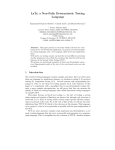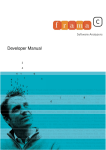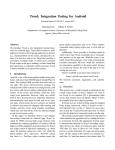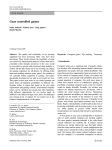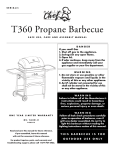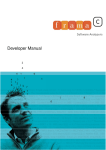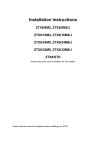Download The Ruby Intermediate Language - University of Maryland at
Transcript
The Ruby Intermediate Language ∗
Michael Furr
Jong-hoon (David) An
Jeffrey S. Foster
Michael Hicks
University of Maryland, College Park
{furr,davidan,jfoster,mwh}@cs.umd.edu
Abstract
Ruby is a popular, dynamic scripting language that aims to “feel
natural to programmers” and give users the “freedom to choose”
among many different ways of doing the same thing. While this arguably makes programming in Ruby easier, it makes it hard to build
analysis and transformation tools that operate on Ruby source code.
In this paper, we present the Ruby Intermediate Language (RIL),
a Ruby front-end and intermediate representation that addresses
these challenges. RIL includes an extensible GLR parser for Ruby,
and an automatic translation into an easy-to-analyze intermediate
form. This translation eliminates redundant language constructs,
unravels the often subtle ordering among side effecting operations,
and makes implicit interpreter operations explicit. We also describe
several additional useful features of RIL, such as a dynamic instrumentation library for profiling source code and a dataflow analysis engine. We demonstrate the usefulness of RIL by presenting a
static and dynamic analysis to eliminate null pointer errors in Ruby
programs. We hope that RIL’s features will enable others to more
easily build analysis tools for Ruby, and that our design will inspire
the creation of similar frameworks for other dynamic languages.
Categories and Subject Descriptors D.3.3 [Programming Languages]: Language Constructs and Features—Frameworks; F.3.2
[Logics and Meanings of Programs]: Semantics of Programming
Languages—Program analysis
General Terms Languages
Keywords Ruby, Intermediate language, RIL, profile-guided analysis
1.
Introduction
Ruby is a popular, object-oriented, dynamic scripting language
inspired by Perl, Python, Smalltalk, and LISP. Over the last several
years, we have been developing tools that involve static analysis
and transformation of Ruby code. The most notable example is
Diamondback Ruby (DRuby), a system that brings static types and
static type inference to Ruby [5, 4].
As we embarked on this project, we quickly discovered that
working with Ruby code was going to be quite challenging. Ruby
aims to “feel natural to programmers” [19] by providing a rich
∗ This
research was supported in part by DARPA ODOD.HR00110810073
Permission to make digital or hard copies of all or part of this work for personal or
classroom use is granted without fee provided that copies are not made or distributed
for profit or commercial advantage and that copies bear this notice and the full citation
on the first page. To copy otherwise, to republish, to post on servers or to redistribute
to lists, requires prior specific permission and/or a fee.
DLS’09, October 26, 2009, Orlando, Florida, USA.
c 2009 ACM 978-1-60558-769-1/09/10. . . $10.00
Copyright syntax that is almost ambiguous, and a semantics that includes
a significant amount of special case, implicit behavior. While the
resulting language is arguably easy to use, its complex syntax and
semantics make it hard to write tools that work with Ruby source
code.
In this paper, we describe the Ruby Intermediate Language
(RIL), an intermediate language designed to make it easy to extend, analyze, and transform Ruby source code. As far as we are
aware, RIL is the only Ruby front-end designed with these goals in
mind. RIL provides four main advantages for working with Ruby
code. First, RIL’s parser is completely separated from the Ruby interpreter, and is defined using a Generalized LR (GLR) grammar,
which makes it much easier to modify and extend. In particular,
it was rather straightforward to extend our parser grammar to include type annotations, a key part of DRuby. (Section 2.) Second,
RIL translates many redundant syntactic forms into one common
representation, reducing the burden on the analysis writer. For example, Ruby includes four different variants of if-then-else (standard, postfix, and standard and postfix variants with unless), and
all four are represented in the same way in RIL. Third, RIL makes
Ruby’s (sometimes quite subtle) order of evaluation explicit by assigning intermediate results to temporary variables, making flowsensitive analyses like dataflow analysis simpler to write. Finally,
RIL makes explicit much of Ruby’s implicit semantics, again reducing the burden on the analysis designer. For example, RIL replaces empty Ruby method bodies by return nil to clearly indicate
their behavior. (Section 3.)
In addition to the RIL data structure itself, our RIL implementation has a number of features that make working with RIL easier. RIL includes an implementation of the visitor pattern to simplify code traversals. The RIL pretty printer can output RIL as executable Ruby code, so that transformed RIL code can be directly
run. To make it easy to build RIL data structures (a common requirement of transformations, which often inject bits of code into
a program), RIL includes a partial reparsing module [2]. RIL also
has a dataflow analysis engine, and extensive support for run-time
profiling. We have found that profiling dynamic feature use and
reflecting the results back into the source code is a good way to
perform static analysis in the presence of highly dynamic features,
such as eval [4]. (Section 4.)
RIL is written in OCaml [10], which we found to be a good
choice due to its support for multi-paradigm programming. For example, its data type language and pattern matching features provide strong support for manipulating the RIL data structure, the
late binding of its object system makes visitors easier to re-use, and
RIL’s dataflow and profiling libraries can be instantiated with new
analyses using functors.
Along with DRuby [5, 4], we have used RIL to build DRails, a
tool that brings static typing to Ruby on Rails applications [6]. In
addition, several students in a graduate class at the University of
Maryland used RIL for a course project. The students were able to
build a working Ruby static analysis tool within a few weeks. These
experiences lead us to believe that RIL is a useful and effective tool
for analysis and transformation of Ruby source code. We hope that
others will find RIL as useful as we have, and that our discussion of
RIL’s design will be valuable to those working with other dynamic
languages with similar features. RIL is available as part of the
DRuby distribution at http://www.cs.umd.edu/projects/PL/
druby.
2.
Language Ambiguities
We illustrate the challenges in parsing Ruby with three examples.
First, consider an assignment x = y. This looks innocuous enough,
but it requires some care in the parser: If y is a local variable,
then this statement copies the value of y to x. But if y is a method
(lower case identifiers are used for both method names and local
variables), this statement is equivalent to x = y(), i.e., the righthand side is a method call. Thus we can see that the meaning of an
identifier is context-dependent.
Such context-dependence can manifest in even more surprising
ways. Consider the following code:
1
2
3
4
5
6
def x() return 4 end
def y()
if false then x = 1 end
x +2
# error , x is nil , not a method call
end
Even though the assignment on line 3 will never be executed,
its existence causes Ruby’s parser to treat x as a local variable
from there on. At run-time, the interpreter will initialize x to nil
after line 3, and thus executing x + 2 on line 4 is an error. In
contrast, if line 3 were removed, x + 2 would be interpreted as
x() + 2, evaluating successfully to 6. (Programmers might think
that local variables in Ruby must be initialized explicitly, but this
1 There
is a pseudo-BNF formulation of the Ruby grammar in the on-line
Ruby 1.4.6 language manual, but it is ambiguous and ignores the many
exceptional cases [11].
f () do |x| x + 1 end
Here we invoke the method f, passing a code block (higher-order
method) as an argument. In this case the code block, delimited by
do ... end, takes parameter x and returns x + 1.
It turns out that code blocks can be used by several different
constructs, and thus their use can introduce potential ambiguity.
For example, the statement:
Parsing Ruby
The major features of Ruby are fairly typical of dynamic scripting
languages. Among other features, Ruby includes object-orientation
(every value in Ruby is an object, including integers); exceptions;
extensive support for strings, regular expressions, arrays, and hash
tables; and higher-order programming (code blocks). We assume
the reader is familiar with, or at least can guess at, the basics of
Ruby. An introduction to the language is available elsewhere [20,
3].
The first step in analyzing Ruby is parsing Ruby source. One
option would be to use the parser built in to the Ruby interpreter.
Unfortunately, that parser is tightly integrated with the rest of the
interpreter, and uses very complex parser actions to handle the
ambiguity of Ruby’s syntax. We felt these issues would make it
difficult to extend Ruby’s parser for our own purposes, e.g., to add
a type annotation language for DRuby.
Thus, we opted to write a Ruby parser from scratch. The fundamental challenge in parsing Ruby stems from Ruby’s goal of giving
users the “freedom to choose” among many different ways of doing
the same thing [21]. This philosophy extends to the surface syntax,
making Ruby’s grammar highly ambiguous from an LL/LR parsing
standpoint. In fact, we are aware of no clean specification of Ruby’s
grammar.1 Thus, our goal was to keep the grammar specification as
understandable (and therefore as extensible) as possible while still
correctly parsing all the potentially ambiguous cases. Meeting this
goal turned out to be far harder than we originally anticipated, but
we were ultimately able to develop a robust parser.
2.1
example shows that the parsing context can actually lead to implicit
initialization.)
As a second parsing challenge, consider the code:
7
for x in 1..5 do puts x end
prints the values 1 through 5. Notice that the body of for is also a
code block (whose parameters are defined after the for token)—and
hence if we see a call:
8
for x in f () do ... end ...
then we need to know whether the code block is being passed to
f() or is used as the body of the for. (In this case, the code block is
associated with the for.)
Finally, a third challenge in parsing Ruby is that method calls
may omit parentheses around their arguments in some cases. For
example, the following two lines are equivalent:
9
10
f (2∗3, 4)
f 2∗3, 4
However, parentheses may also be used to group sub-expressions.
Thus, a third way to write the above method call is:
11
f (2∗3),4
Of course, such ambiguities are a common part of many languages,
but Ruby has many cases like this, and thus using standard techniques like refactoring the grammar or using operator precedence
parsing would be quite challenging to maintain.
2.2
A GLR Ruby Parser
To meet these challenges and keep our grammar as clean as possible, we built our parser using the dypgen generalized LR (GLR)
parser generator, which supports ambiguous grammars [14]. Our
parser uses general BNF-style productions to describe the Ruby
grammar, and without further change would produce several parse
trees for conflicting cases like those described above. To indicate
which tree to prefer, we use helper functions to prune invalid parse
trees, and we use merge functions to combine multiple parse trees
into a single, final output.
An excerpt from our parser is given in Figure 1. Line 9 delimits
the OCaml functions defined in the preamble (lines 1–8), versus the
parser productions (lines 10–27). A dypgen production consists of
a list of terminal or non-terminal symbols followed by a semantic
action inside of {}’s. The value of a symbol may be bound using
[]’s for later reference. For example, the non-terminal stmt list[ss]
reduces to a list of statements that is bound to the identifier ss in
the body of the action.
The production primary, defined on line 10, handles expressions
that may appear nested within other expressions, like a subexpression block (line 11), a method call (line 13) or a for loop
(line 14). On line 16, the action for this rule calls the helper function
well formed do to prune ill-formed sub-trees. The well formed do
function is defined in the preamble of the parser file, and is shown
on lines 1–4. This function checks whether an expression ends with
a method call that includes a code block and, if so, it raises the
Dyp.Giveup exception to tell dypgen to abandon this parse tree. This
1
2
3
4
5
6
7
8
9
10
11
12
13
14
15
16
17
18
19
20
21
22
23
24
25
26
27
let well formed do guard body = match ends with guard with
| E MethodCall( , ,Some (E CodeBlock(false, , , )), ) →
raise Dyp.Giveup
|
→()
let well formed command m args = match args with
| [E Block ] → raise Dyp.Giveup
| ...
%%
primary :
| T LPAREN[pos] stmt list[ss ] T RPAREN
{ E Block(ss ,pos) }
| func[ f ] { f }
| K FOR[pos] formal arg list [ vars ] K IN arg[guard]
do sep stmt list [body] K lEND
{ well formed do guard body; E For(vars ,range,body,pos) }
command:
| command name[m] call args[args]
{ well formed command m args;
methodcall m args None (pos of m)}
| ...
func :
| command name[m] T LPAREN call args[args] T RPAREN
{ methodcall m args None (pos of m) }
| ...
Figure 1. Example GLR Code
rule has the effect of disambiguating the for...do..end example by
only allowing the correct parse tree to be valid. Crucially, this rule
does not require modifying the grammar for method calls, keeping
that part of the grammar straightforward.
We use a similar technique to disambiguate parentheses for
method calls. The command (line 18) and func (line 24) productions define the rules for method calls with and without parentheses
respectively. Each includes a list of arguments using the call args
production (not shown), which may reduce to the primary production (line 10). As with the action of the for production, the command
production calls the helper function well formed command to prune
certain parse trees. This function (line 6) aborts the parse if the
method call has a single argument that is a grouped sub-expression
(stored in the E Block constructor).
Figure 2 shows how our grammar would attempt to parse four
variations of a Ruby method call. The first column shows the
source syntax, and the last two columns show the result of using
either func or command to parse the code. As the GLR parsing
algorithm explores all possible parse trees, dypgen will attempt to
use both productions to parse each method call. The first variation,
f(x, y), fails to parse using the command production since the subexpression production on line 11 must apply, but the pair x, y is not
a valid (isolated) Ruby expression. Similarly, the second example
does not parse using func since it would reduce f(x) to a method
call, and be left with the pair (f(x)), y which is invalid for the
same reason. The third example, f x, y would only be accepted by
the command production as it contains no parentheses. Thus, our
productions will always produce a single parse tree for method
calls with at least 2 arguments. However, the last variation f(x)
would be accepted by both productions, producing two slightly
different parse trees: f(x) vs f((x)). To choose between these,
the well formed command function rejects a function with a single
E Block argument (line 7), and thus only the func production will
succeed.
By cleanly separating out the disambiguation rules in this way,
the core productions are relatively easy to understand, and the
Ruby source
command
func
f
f
f
f
comma in sub-expr
success
success
raise Giveup
success
comma after reduction
no parens
success
(x,y)
(x ), y
x,y
(x)
Figure 2. Disambiguation example
parser is easier to maintain and extend. For example, as we discovered more special parsing cases baked into the Ruby interpreter, we
needed to modify only the disambiguation rules and could leave the
productions alone. Similarly, adding type annotations to individual
Ruby expressions required us to only change a single production
and for us to add one OCaml function to the preamble. We believe that our GLR specification comes fairly close to serving as
a standalone Ruby grammar: the production rules are quite similar
to the pseudo-BNF used now [11], while the disambiguation rules
describe the exceptional cases. Our parser currently consists of 75
productions and 513 lines of OCaml for disambiguation and helper
functions.
Since Ruby has no official specification, we used three techniques to establish our parser is compatible with the existing ”reference” parser, which is part of the Ruby 1.8 interpreter. First, we
verified that our parser can successfully parse a large corpus of
over 160k lines of Ruby code without any syntax errors. Second,
we developed 458 hand-written unit tests that ensure Ruby syntax
is correctly parsed into known ASTs. For example, we have tests
to ensure that both f x, y and f (x), y are parsed as two-argument
method calls. Finally, we parse and then unparse to disk the test
suite shipped with the Ruby interpreter. This unparsed code is then
executed to ensure the test suite still passes. This last technique is
also used to verify that our pretty printing module and the semantic
transformations described in Section 3 are correct (these modules
each have their own unit test suites as well).
3.
Ruby Intermediate Language
Parsing Ruby source produces an abstract syntax tree, which we
could then try to analyze and transform directly. However, like most
other languages, Ruby AST’s are large, complex, and difficult to
work with. Thus, we developed the Ruby Intermediate Language
(RIL), which aims to be low-level enough to be simple, while being
high-level enough to support a clear mapping between RIL and the
original Ruby source. This last feature is important for tools that
report error messages (e.g., the type errors produced by DRuby),
and to make it easy to generate working Ruby code directly from
RIL.
RIL provides three main advantages: First, it uses a common
representation of multiple, redundant source constructs, reducing
the number of language constructs that an analysis writer must handle. Second, it makes the control-flow of a Ruby program more
apparent, so that flow-sensitive analyses are much easier to write.
Third, it inserts explicit code to represent implicit semantics, making the semantics of RIL much simpler than the semantics of Ruby.
We discuss each of these features in turn.
3.1
Eliminating Redundant Constructs
Ruby contains many equivalent constructs to allow the programmer
to write the most “natural” program possible. We designed RIL to
include only a small set of disjoint primitives, so that analyses need
to handle fewer cases. Thus, RIL translates several different Ruby
source constructs into the same canonical representation.
As an example of this translation, consider the following Ruby
statements:
(1) if p then e end
(3) e if p
(2) unless (not p) then e end (4) e unless (not p)
result =
begin
if p then a() end
rescue Exception => x
b()
ensure
c()
end
(a) Ruby code
Ruby
begin
if p then
t1 = a()
else
t1 = nil
end
rescue Exception => x
t1 = b()
ensure
c()
end
result = t1
(b) RIL Translation
s = ”Here’s Johnny”
s = ’Here\’s Johnny’
s = %{Here’s Johnny}
s = <<EOF
Here’s Johnny
EOF
RIL performs several other additional simplifications. Operators
are replaced by the method calls they represent, e.g., x + 2 is translated into x.+(2); while and until are coalesced; logical operators
such as and and or are expanded into sequences of conditions, similarly to CIL [12]; and negated forms (e.g., ! =) are translated into
a positive form (e.g., ==) combined with a conditional.
All of these translations serve to make RIL much smaller than
Ruby, and therefore there are many fewer cases to handle in a RIL
analysis as compared to an analysis that would operate on Ruby
ASTs.
3.3
a (). f ,x = b().g
b,g,a, f=
Materializing Implicit Constructs
Finally, Ruby’s rich syntax tries to minimize the effort required
for common operations. As a consequence, many expressions and
method calls are inserted “behind the scenes” in the Ruby interpreter. We already saw one example of this above, in which fallthough cases of conditionals return nil. A similar example is empty
method bodies, which also evaluate to nil.
There are many other constructs with implicit semantics. For
example, it is very common for a method to call the superclass’s
implementation using the same arguments that were passed to it.
In this case, Ruby allows the programmer to omit the arguments
altogether and implicitly uses the same values passed to the current
method. For example, in the following code:
Linearization
In Ruby, almost any construct can be nested inside of any other
construct, which makes the sequencing of side effects tricky and
tedious to unravel. In contrast, each statement in RIL is designed to
perform a single semantic action such as a branch or a method call.
As a result, the order of evaluation is completely explicit in RIL,
which makes it much easier to build flow-sensitive analyses, such
as dataflow analysis.
To illustrate some of the complexities of evaluation order in
Ruby, consider the code in Figure 3(a). Here, the result of an
exception handling block is stored into the variable result. If an
analysis needs to know the value of the right-hand side and only
has the AST to work with, it would need to descend into exception
block and track the last expression on every branch, including the
exception handlers.
Figure 3(b) shows the RIL translation of this fragment, which
inlines an assignment to a temporary variable on every viable return
path. Notice that the value computed by the ensure clause (this
construct is similar to finally in Java) is evaluated for its side effect
only, and is not returned. Also notice that the translation has added
an explicit nil assignment for the fall-through case for if. (This is
an example of implicit behavior, discussed more in Section 3.3.)
These sorts of details can be very tricky to get right, and it took a
significant effort to find and implement these cases. RIL performs
a,b,g, f=
similar translations for ensuring that every path through a method
body ends with a return statement and that every path through a
block ends with a next statement2 .
Another problematic case for order-of-evaluation in Ruby arises
because of Ruby’s many different assignment forms. In Ruby, fields
are hidden inside of objects and can only be manipulated through
method calls. Thus using a “set method” to update a field is very
common, and so Ruby includes special syntax for allowing a set
method to appear on the left hand side of an assignment. The
syntax a.m = b is equivalent to sending the m= message with
argument b to the object a. However, as this syntax allows method
calls to appear on both sides of the assignment operator, we must
be sure to evaluate the statements in the correct order. Moreover,
the evaluation order for these constructs can vary depending on
the whether the assignment is a simple assignment or a parallel
assignment.
Figure 4 demonstrates this difference. The first column lists two
similar Ruby assignment statements whose only difference is that
the lower one assigns to a tuple (the right-hand side must return
a two-element array, which is then split and assigned to the two
parts of the tuple). The second column lists the method call order—
notice that a is evaluated at a different time in the two statements.
The third column gives the corresponding RIL code, which makes
the evaluation order clear. Again, these intricacies were hard to
discover, and eliminating them makes RIL much easier to work
with.
All of these statements are equivalent, and RIL translates them all
into form (1).
As another example, there are many different ways to write
string literals, and the most appropriate choice depends on the
contents of the string. For instance, below lines 1, 2, 3, and 4–6
all assign the string Here0 s Johnny to s, while RIL represents all
four cases internally using the third form:
3.2
a (). f = b().g
RIL
t1 = a()
t3 = b()
t2 = t3.g()
t1 . f=(t2)
t2 = b()
t1 = t2.g()
(t4 , x) = t1
t3 = a()
t3 . f=(t4)
Figure 4. RIL Linearization Example
Figure 3. Nested Assignment
1
2
3
4
5
6
Method Order
1
2
3
4
5
6
7
8
9
class A
def foo(x,y) ... end
end
class B < A
def foo(x,y)
...
super
end
end
2 next
acts as a local return from inside of a block.
1
2
3
4
5
class Format
[‘‘ bold’ ’ ,‘‘ underline ’ ’ ]. each do | str |
eval ‘‘ def #{str}() @#{str} end’’
end
end
(a) Original, Dynamic Code
1
2
3
4
5
6
7
8
9
10
11
class Format
[‘‘ bold’ ’ ,‘‘ underline ’ ’ ]. each do | str |
case ‘‘ def #{str}() @#{str} end’’
when ‘‘‘ def bold() @bold end’’
def bold() @bold end
when ‘‘def underline () @underline end’’
def underline () @underline end
else safe eval ‘‘ def #{str}() @#{str} end’’
end
end
end
(b) Transformed Code
Figure 5. Profiling Example
the call on line 7 is the same as super(x,y), which is what RIL
translates the call to. Without this transformation, every analysis
would have to keep track of these parameters itself, or worse,
mistakenly model the call on line 7 as having no actual arguments.
One construct with subtle implicit semantics is rescue. In Figure 3(b), we saw this construct used with the syntax rescue C => x,
which binds the exception to x if it is an instance of C (or a subclass of C). However, Ruby also includes a special abbreviated form
rescue => x, in which the class name is omitted. The subtlety is
that, contrary to what might be expected, a clause of this form does
not match arbitrary exceptions, but instead only matches instances
of StandardError, which is a superclass of many, but not all exceptions. To make this behavior explicit, RIL requires every rescue
clause to have an explicit class name, and inserts StandardError in
this case.
Finally, Ruby is often used to write programs that manipulate strings. As such, it contains many useful constructs for
working with strings, including the # operator, which inserts
a Ruby expression into the middle of a string. For example,
‘‘ Hi #{x.name}, how are you?’’ computes x.name, invokes its
to s method to convert it to a string, and then inserts the result
using concatenation. Notice that the original source code does not
include the call to to s. Thus, RIL both replaces uses of # with
explicit concatenation and makes the to s calls explicit. The above
code is translated as:
1
2
3
t1 = x.name
t2 = ‘‘Hi ’ ’ + t1. to s
t2 + ‘‘, how are you?’ ’
Similar to linearization, by making implicit semantics of constructs explicit, RIL enjoys a much simpler semantics than Ruby.
In essence, like many other intermediate languages, the translation
to RIL encodes a great deal of knowledge about Ruby and thereby
lowers the burden on the analysis designer. Instead of having to
worry about many complex language constructs, the RIL user has
fewer, mostly disjoint cases to be concerned with, making it easier
to develop correct Ruby analyses.
then parses and evaluates that string as ordinary Ruby code. As
this string may contain any valid Ruby expression, uses of eval can
easily make a static analysis unsound. To precisely analyze code
containing eval, we need to know what strings may be passed to
eval at run time. We could try to do this with a purely static analysis
(approximating what the string arguments could be), but doing so
would likely be quite imprecise. Instead, we developed a dynamic
analysis library that, among other things, lets us profile dynamic
constructs. Our most complex RIL client to date, Diamondback
Ruby, uses this infrastructure to replace dynamic constructs with
static constructs according to a program’s test suite [4].
For example, Figure 5(a) shows a Ruby program that uses eval
to define a pair of methods, bold and underline. Without knowing
the result of the eval statement, a static analysis would be unable to
reason about the presence of these methods (e.g., DRuby would
produce type errors at their call sites). However, an important
property of this code is that the eval occurs at the top level of
the class—and so it will always be executed—and it will always
evaluate the same strings. Thus the effects of this call are essentially
static.
RIL includes a transformation for eval statements (and other
dynamic features) that, when invoked, will produce the code similar to that shown in Figure 5(b). Here, the eval statement has been
replaced with a case statement that first checks the string against
those observed by the program execution, and includes the corresponding program source directly in the method body. The result of
this transformation is a modified program that makes the effects of
the eval explicit in the source. Thus, any static analysis that walks
the source tree could benefit from this transformation. We found
that many dynamic features in Ruby are used in essentially static
ways, making this technique effective in practice [4].
The architecture of RIL’s dynamic analysis library is shown in
Figure 6 and consists of five main stages. We assume that we have
a set of test cases under which we run the program to gather profiles. First, we execute the target program (using the test cases),
but with a special Ruby file preloaded that redefines require, the
method that loads another file. Our new version of require behaves
as usual, except it also records all of the files that are loaded during the program’s execution. This is because require has dynamic
behavior, like eval: Ruby programs may dynamically construct file
names to pass to require (and related constructs) or even redefine
the semantics of the require method.
After we have discovered the set of application files, in stage
two we instrument each file to record profiling information. This
transformation modifies the Ruby code to track strings passed to
eval and several other dynamic constructs. We then unparse the
modified source files to disk using RIL’s pretty printer and execute
the resulting program. Here we must be very careful to preserve
the execution environment of the process, e.g., the current working
directory, the name of the executed script (stored in the Ruby global
$0), and the name of the file (stored in FILE in Ruby). When the
execution is complete, we serialize all of the profiled data to disk
using YAML, a simple markup language supported by both Ruby
and OCaml [22]. Finally, we read in the gathered profiles and use
them to transform the original source code prior to applying our
main analysis.
To use our dynamic analysis library, a client must provide the
instrumentation used in stage two, and the transformation in stage
four. We discuss each of these by example in Section 5.3.
5.
4.
Profiling Dynamic Constructs
An important feature of Ruby that any static analysis must handle
is its use of dynamic features such as eval. When eval(e) is called,
the Ruby interpreter evaluates e, which must return a string, and
Using RIL
In this section, we demonstrate RIL by developing a simple dynamic null pointer analysis that uses a source to source transformation to prevent methods from being called on nil. We then construct
a dataflow analysis to improve the performance of the transformed
I
II
IV
V
main.rb
Require
Document
All Files
Transform
Final Files
Static Analysis
III
Instrument
/tmp/files
YAML
Document
Runtime
Stubs
Figure 6. Dynamic Instrumentation Architecture
code. Finally, we use our profiling library to further optimize functions that are verified with a test suite. Along the way, we illustrate some of the additional features our implementation provides
to make it easier to work with RIL. In our implementation, RIL is
represented as an OCaml data structure, and hence all our examples
below are written in OCaml.
5.1
1
2
3
4
Here the string passed on line 3 describes the concrete syntax, just
as above, with %a wherever we need “hole” in the string. We pass
targ for the first hole, and node for the second. As is standard for
the %a format specifier in OCaml, we also pass functions (in this
case, format expr and format stmt) to transform the corresponding arguments into strings.
Note that one potential drawback of reparsing is that reparse
will complain at run-time if mistakenly given unparsable strings;
constructing RIL data structures directly in OCaml would cause
mistakes to be flagged at compile-time, but such direct construction
is far more tedious. Also, recall from Section 2 that parsing in Ruby
is highly context-dependent. Thus, on line 2 we pass node.locals as
the optional argument env to ensure that the parser has the proper
state to correctly parse this string in isolation.
Eliminating Nil Errors
We will develop an example Ruby-to-Ruby transformation written
with RIL. Our transformation modifies method calls such that if the
receiver object is nil then the call is ignored rather than attempted.
In essence this change makes Ruby programs oblivious [16] to
method invocations on nil, which normally cause exceptions3 . As
an optimization, we will not transform a call if the receiver is self,
since self can never be nil. Our example transformation may or may
not be useful, but it works well to demonstrate the use of RIL.
RIL includes an implementation of the visitor pattern that is
modeled after CIL [12]. A visitor object includes a (possibly inherited) method for each RIL syntactic variant (statement, expression,
and so on) using pattern matching to extract salient attributes. The
code for our safeNil visitor class is as follows:
1
2
3
4
5
6
7
8
class safeNil = object
inherit default visitor as super
method visit stmt node = match node.snode with
| MethodCall( , {mc target=‘ID Self}) → SkipChildren
| MethodCall( , {mc target=#expr as targ}) →
ChangeTo (transform targ node)
|
→ super#visit stmt node
end
The safeNil class inherits from default visitor (line 2), which performs no actions. We then override the inherited visit stmt method
to get the behavior we want: method calls whose target is self are
ignored, and we skip visiting the children (line 4). This is sensible because RIL method calls do not have any statements as subexpressions, thanks to the linearization transformation mentioned
in Section 3.2. Method calls with non-self receivers are transformed (lines 5–6). Any other statements are handled by the superclass visitor (line 7), which descends into any sub-statements
or -expressions. For example, at an if statement, the visitor would
traverse the true and false branches.
To implement the transformation on line 6, we need to create
RIL code with the following structure, where E is the receiver
object and M is the method invocation:
1
if E.nil? then nil else M end
To build this code, RIL includes a partial reparsing module [2] that
lets us mix concrete and abstract syntax. To use it, we simply call
RIL’s reparse function:
3 In
fact, nil is a valid object in Ruby and does respond to a small number
of methods, so some method invocations on nil would be valid.
let transform targ node =
reparse ˜env:node. locals
” if %a.nil? then nil else %a end”
format expr targ format stmt node
5.2
Dataflow Analysis
The above transformation is not very efficient because it transforms
every method call with a non-self receiver. For example, the transformation would instrument the call to + in the following code,
even though we can see that x will always be an integer.
1
2
if p then x = 3 else x = 4 end
x +5
To address this problem, we can write a static analysis to track the
flow of literals through the current scope (e.g., a method body),
and skip instrumenting any method call whose receiver definitely
contains a literal.
We can write this analysis using RIL’s built-in dataflow analysis
engine. To specify a dataflow analysis [1] in RIL, we supply a
module that satisfies the following signature:
1
2
3
4
5
6
7
8
9
10
module type DataFlowProblem =
sig
type t
(∗ abstract type of facts ∗)
val top : t
(∗ initial fact for stmts ∗)
val eq : t → t → bool
(∗ equality on facts ∗)
val to string : t → string
val transfer : t → stmt → t
val meet : t list → t
end
(∗ transfer function ∗)
(∗ meet operation ∗)
Given such a module, RIL includes basic support for forwards
and backwards dataflow analysis; RIL determines that a fixpoint
has been reached by comparing old and new dataflow facts with
eq. This dataflow analysis engine was extremely easy to construct
because each RIL statement has only a single side effect.
For this particular problem, we want to determine which local
variables may be nil and which definitely are not. Thus, we begin
our dataflow module, which we will call NilAnalysis, by defining
the type t of dataflow facts to be a map from local variable names
(strings) to facts, which are either MaybeNil or NonNil:
1
2
3
4
module NilAnalysis = struct
type t = fact StrMap.t
and fact = MaybeNil | NonNil (∗ core dataflow facts ∗)
...
We omit the definitions of top, eq, to string, and meet, as
they are uninteresting. Instead, we will present only the transfer
function and a small helper function to demonstrate working with
RIL’s data structures. The function transfer takes as arguments the
input dataflow facts map, a statement stmt, and returns the output
dataflow facts:
1
2
3
4
5
6
7
8
9
10
11
12
13
14
15
16
let rec transfer map stmt = match stmt.snode with
| Assign( lhs , # literal ) → update lhs NonNil map lhs
| Assign( lhs , ‘ID Var(‘Var Local , rvar )) →
update lhs (StrMap.find rvar map) map lhs
| MethodCall(Some lhs, ) | Yield (Some lhs, )
| Assign( lhs , ) → update lhs MaybeNil map lhs
|
→ map
1
2
3
4
5
6
7
8
9
10
11
12
4 Perhaps
surprisingly, nil itself is actually an identifier in Ruby rather than
a literal, and RIL follows the same convention.
Dynamic Analysis
Section 4 discussed the need for handling dynamic features such
as eval. Indeed a call to eval could make our nil analysis unsound,
since it could overwrite local variables with nil. However, because
the eval analysis is orthogonal to DRuby’s type system, our example analysis can instantly take advantage of it by operating on the
transformed source like that presented in Figure 5(b).
However, our dynamic analysis library could also be used to
reduce the overhead of our transformed code. Currently, we use an
intraprocedural dataflow analysis, and so method parameters are
conservatively assumed to be MaybeNil by our analysis. While
public methods may need to handle nil values (possibly by simply
throwing an informative exception), private methods might have
stronger assumptions, since they can only be called from within the
current class. If we could prove a private method is only invoked
with non-nil values, our analysis could take this information into
account. It may be possible to do this with a sufficiently advanced
static analysis, but another option would be to use a dynamic
analysis to ensure this property holds.
Our strategy is as follows. First, we will instrument the program
to ensure that selected methods are only passed non-nil values. Second, we will execute the test suite, to check that these invariants
hold. Finally, we will transform the program using a slightly improved dataflow analysis that takes this runtime data into account.
To simplify the presentation, we only track if all of a method’s
arguments are non-nil, instead of tracking them individually. In
reality, we could treat each parameter separately without much
difficulty.
(∗ val update : string → fact → t → t ∗)
end
module NilDataFlow = Dataflow.Forwards(NilAnalysis)
... (∗ safeNil visitor ∗)
| Method(name,args,body) →
let init facts = init formals args MaybeNil in
let in facts , = NilDataFlow.fixpoint body init facts in
(∗ visit body ∗)
| MethodCall( ,
{mc target=(‘ID Var(‘Var Local, var) as targ )}) →
let map = Hashtbl.find in facts node in
begin match StrMap.find var map with
| MaybeNil → ChangeTo(transform targ node)
| NonNil → SkipChildren
end
5.3
and update lhs fact map lhs = match lhs with
| ‘ID Var(‘Var Local , var) → update var fact map
| # identifier → map
| ‘Tuple lst → List. fold left ( update lhs MaybeNil) map lst
| ‘ Star (#lhs as l ) → update lhs NonNil map l
The first case we handle is assigning a literal (line 2). Since literals
are never nil, line 2 uses the helper function update lhs to mark the
left-hand side of the assignment as non-nil4 .
The function update lhs has several cases, depending on the
left-hand side. If it is a local variable, that variable’s dataflow fact
is updated in the map (line 10). If the left-hand side is any other
identifier (such as a global variable), the update is ignored, since
our analysis only applies to local variables. If the left-hand side is a
tuple (i.e., it is a parallel assignment), then we recursively apply the
same helper function but conservatively mark the tuple components
as MaybeNil. The reason is that parallel assignment can be used
even when a tuple on the left-hand side is larger than the value on
the right. For example x,y,z = 1,2 will store 1 in x, 2 in y and nil in
z. In contrast, the star operator always returns an array (containing
the remaining elements, if any), and hence variables marked with
that operator will never be nil (line 13). For example, x,y,∗z = 1,2
will set x and y to be 1 and 2, respectively, and will set z to be a
0-length array.
Going back to the main transfer function, lines 3–4 match statements in which the right-hand side is a local variable. We look up
that variable in the input map, and update the left-hand side accordingly. Lines 5–6 match other forms that may assign to a local
variable, such as method calls. In these cases, we conservatively assume the result may be nil. Finally, line 7 matches any other statement forms that do not involve assignments, and hence do not affect
the propagation of dataflow facts.
To use our NilAnalysis module, we instantiate the dataflow
analysis engine with NilAnalysis as the argument:
1
Finally, we add two new cases to our original visitor. First, we
handle method definitions (lines 2–5) where we invoke the fixpoint
function on the body of the method. fixpoint takes a RIL statement
and an initial set of dataflow facts (init formals sets each formal
argument to MaybeNil) and returns two hash tables, which provide
the input and output facts at each statement (line 4 ignores the
latter). Second, we check if a method target is a local variable and
skip the instrumentation if it is NonNil (lines 6–12):
Instrumentation To record data from a profiled execution, RIL
provides a small runtime library for collecting and storing application values to disk. Data is passed to this library by inserting explicit
calls into the application using RIL’s instrumentation pass (stage II
in Figure 6). Thus, the first step in building a new dynamic analysis
is to register a new collection class with our runtime library:
1
2
3
4
5
6
7
8
9
10
class DRuby:: Profile
class Dynnil < Interceptor
def initialize ( collector )
super( collector , ”dynnil”)
end
def Dynnil. extract (recv ,mname,∗args)
args . all ? {|x| !x. nil ?}
end
end
end
Here, we define the class Dynnil, which inherits from the base
class Interceptor that is part of RIL. Our class then defines two
methods, a constructor on lines 3–5 that registers our module with
the data collection object under the name “dynnil,” and a class
method extract, which collects the data of interest. In our case,
it returns true if all of the arguments to a method call are non-nil,
and false otherwise. The RIL runtime library will instantiate this
class automatically at runtime, providing an appropriate instance
of collector to the constructor.
To use this class, we create an OCaml module that uses RIL’s
visitors to instrument the application’s methods, inserting calls to
the runtime library.
1
2
3
4
5
6
7
8
9
10
11
12
module NilProfile : DynamicAnalysis = struct
let name = ”dynnil”
let instrument mname args body pos =
let file , line = get pos pos in
let code = reparse ˜env:body. lexical locals
”DRuby::Profile :: Dynnil.watch(’%s’,%d, self ,’%a’,[%a ]) ”
file line format def name mname
(format comma list format param) args
in
let body’ = seq [code;body] body.pos in
meth mname args body’ pos
We begin our module, called NilProfile, by declaring the name
of our Ruby collection on line 2 (matching the string used in the
constructor above). Next, lines 4–12 define the function instrument
method, which inserts a call to the watch method, a method that
Dynnil inherits from the Interceptor class. This method calls our
overloaded extract method as a subroutine and stores the boolean
result along with the given filename, line number, and method name
in the YAML store. Like our example in Section 5.1, we construct a
call to watch using our reparsing module (lines 6–9), and prepend
it to the front of the method body using the seq function (line 11),
which creates a sequence of statements. Finally, we construct a new
method definition using the helper meth (line 12). The effect of this
instrumentation is shown below:
1
2
3
4
5
6
7
8
def add(x,y) # before
x +y
end
def add(x,y) # after
DRuby:: Profile :: Dynnil.watch(” file . rb” ,1, self ,”add”,[x,y ])
x +y
end
Lastly, we invoke the instrument method function by constructing a new visitor object that instruments a method on line 6
if should instrument (not shown) returns true and otherwise keeps
the existing method definition (line 7).
1
2
3
4
5
6
7
8
9
class instrument visitor = object( self )
inherit default visitor as super
method visit stmt stmt = match stmt.snode with
| Method(mname,args,body) →
if should instrument stmt
then ChangeTo (instrument mname args body stmt.pos)
else SkipChildren
|
→ super#visit stmt stmt
end
Transformation After our application has been profiled, we can
transform it using our safeNil visitor as defined in Section 5.2. The
only modification we must make is that RIL’s dynamic analysis
library provides us with an additional lookup function, which can
be used to query the YAML store. Thus, we will update the Method
definition case in our visitor, by first checking the YAML store to
see if the arguments are all non-nil, and if so, use stronger dataflow
facts. Our NilProfile OCaml module continues:
13
14
15
16
17
18
19
20
21
22
23
24
25
26
27
28
29
30
31
module Domain = Yaml.YString
module CoDomain = Yaml.YBool
(∗ lookup : Domain.t → pos → CoDomain.t list ∗)
let really nonnil lookup mname pos =
let uses = lookup mname pos in
if uses = [] then false
else not ( List .mem false uses)
... (∗ safeNil visitor ∗)
| Method(mname,args,body) →
let init facts =
if really nonnil lookup mname body.pos
then init formals args NonNil
else init formals args MaybeNil
in
let in facts , = NilDataFlow.fixpoint body init facts in
(∗ visit body ∗)
end
Lines 13–14 define two submodules which define the types we
expect in the YAML store, i.e., a mapping from strings (method
names) to boolean values (only non-nil arguments). RIL will automatically parse the YAML data and ensure it matches these types,
giving us the type-safe lookup function described on line 16. This
function takes a method name and a source location and returns a
list of boolean values recorded at that position, one for each observation. This function is then used by the really nonnil function
which returns false on line 19 if the list is empty (e.g., the method
was never called or not instrumented) or returns false if any of the
observations returned false (line 20). Finally, we update the safeNil
visitor to set the initial dataflow facts for the method formal arguments to NonNil based on the result of really nonnil.
6.
Related Work
There are several threads of related work.
Another project that provides access to the Ruby AST is
ruby parser [17]. This parser is written in Ruby and stores the AST
as an S-expression. ruby parser performs some syntactic simplifications, such as translating unless statements into if statements,
but does no semantic transformations such as linearizing effects
or reifying implicit constructs. The authors of ruby parser have
also developed several tools to perform syntax analysis of Ruby
programs [18]: flay, which detects structural similarities in source
code; heckle, a mutation-based testing tool; and flog, which measures code complexity. We believe these tools could also be written
using RIL, although most of RIL’s features are tailored toward developing analyses that reason about the semantics of Ruby, not just
its syntax.
Several integrated development environments [15, 13] have
been developed for Ruby. These IDEs do some source code analysis
to provide features such as code refactoring and method name completion. However, they are not specifically designed to allow users
to develop their own source code analyses. Integrating analyses developed with RIL into an IDE would be an interesting direction for
future work.
The Ruby developers recently released version 1.9 of the Ruby
language, which includes a new bytecode-based virtual machine.
The bytecode language retains some of Ruby’s source level redundancy, including opcodes for both if and unless statements [23]. At
the same time, opcodes in this language are lower level than RIL’s
statements, which may make it difficult to relate instructions back
to their original source constructs. Since this bytecode formulation
is quite new, it is not yet clear whether it would make it easier to
write analyses and transformations, as was the goal of RIL.
While the Ruby language is defined by its C implementation, several other implementations exist, such as JRuby [8], IronRuby [7], and MacRuby [9]. These projects aim to execute Ruby
programs using different runtime environments, taking advantage
of technologies present on a specific platform. For example, JRuby
allows Ruby programs to execute on the Java Virtual Machine, and
allows Ruby to call Java code and vice versa. While these projects
necessarily include some analysis of the programs, they are not
designed for use as an analysis writing platform.
Finally, RIL’s design was influenced by the C Intermediate
language [12], a project with similar goals for C. In particular,
the authors’ prior experience using CIL’s visitor class, and CIL’s
clean separation of side-effect expressions from statements, lead to
a similar design in RIL.
7.
Conclusion
In this paper, we have presented RIL, the Ruby Intermediate Language. The goal of RIL is to provide a representation of Ruby
source code that makes it easy to develop source code analysis
and transformation tools. Toward this end, RIL includes a GLR
parser designed for modification and extensibility; RIL translates
away redundant constructs; RIL makes Ruby’s order of side effecting operations clear; RIL makes explicit many implicit operations
performed by the Ruby interpreter; and RIL includes dynamic analysis framework for profiling executions of programs. Combined,
we believe these features minimize redundant work and reduce the
chances of mishandling certain Ruby features, making RIL an effective and useful framework for working with Ruby source code.
References
[1] Alfred V. Aho, Ravi Sethi, and Jeffrey D. Ullman. Compilers:
Principles, Techniques, and Tools. Addison Wesley, 1988.
[2] Akim Demaille, Roland Levillain, and Benoı̂t Sigoure. Tweast: a
simple and effective technique to implement concrete-syntax ast
rewriting using partial parsing. In Sung Y. Shin and Sascha Ossowski,
editors, SAC, pages 1924–1929. ACM, 2009.
[3] David Flanagan and Yukihiro Matsumoto. The Ruby Programming
Language. O’Reilly Media, Inc, 2008.
[4] Michael Furr, Jong-hoon (David) An, and Jeffrey S. Foster. Profileguided static typing for dynamic scripting languages. In Proceedings
of the twenty fourth Annual Conference on Object-Oriented Programming Systems, Languages, and Applications, October 2009.
[5] Michael Furr, Jong-hoon (David) An, Jeffrey S. Foster, and Michael
Hicks. Static Type Inference for Ruby. In OOPS Track, SAC, 2009.
[6] Jong hoon (David) An, Avik Chaudhuri, and Jeffrey S. Foster. Static
Typing for Ruby on Rails. In Proceedings of the 24th IEEE/ACM
International Conference on Automated Software Engineering,
Auckland, New Zealand, November 2009. To appear.
[7] IronRuby - Ruby implementation for the .net platform, May 2009.
http://www.ironruby.net/.
[8] JRuby - Java powered Ruby implementation, February 2008.
http://jruby.codehaus.org/.
[9] MacRuby - Ruby implementation built on top of the objectivec common runtime and garbage collector, May 2009. http:
//www.macruby.org/.
[10] Xavier Leroy. The Objective Caml system, August 2004.
[11] Yukihiro Matsumoto. Ruby Language Reference Manual, version
1.4.6 edition, February 1998. http://docs.huihoo.com/ruby/
ruby-man-1.4/yacc.html.
[12] George C. Necula, Scott McPeak, S. P. Rahul, and Westley Weimer.
CIL: Intermediate Language and Tools for Analysis and Transformation of C Programs. In CC, pages 213–228, 2002.
[13] NetBeans - integrated development environment with support for the
Ruby language, May 2009. http://www.netbeans.org/.
[14] Emmanuel Onzon. dypgen User’s Manual, January 2008.
[15] RadRails - Ruby on Rails authoring environment, May 2009.
http://aptana.com/rails/.
[16] Martin C. Rinard, Cristian Cadar, Daniel Dumitran, Daniel M. Roy,
Tudor Leu, and William S. Beebee. Enhancing server availability
and security through failure-oblivious computing. In OSDI, pages
303–316, 2004.
[17] Ruby Parser - Ruby parser written in pure Ruby, May 2009.
http://parsetree.rubyforge.org/.
[18] Flog, Flay, and Heckle - Ruby source analysis tools, May 2009.
http://ruby.sadi.st/.
[19] Bruce Stewart. An Interview with the Creator of Ruby, November
2001. http://www.linuxdevcenter.com/pub/a/linux/2001/
11/29/ruby.html.
[20] Dave Thomas, Chad Fowler, and Andy Hunt. Programming Ruby:
The Pragmatic Programmers’ Guide. Pragmatic Bookshelf, 2nd
edition, 2004.
[21] Bill Venners. The Philosophy of Ruby: A Conversation with Yukihiro
Matsumoto, Part I, September 2003. http://www.artima.com/
intv/rubyP.html.
[22] Yaml: Yaml ain’t markup language, July 2009. http://www.yaml.
org/.
[23] Yarv bytecode table, May 2009. http://lifegoo.pluskid.org/
upload/doc/yarv/yarv_iset.html.










